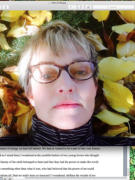Harry Dodge, Artist
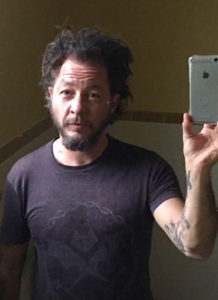 Harry Dodge is an American sculptor, performer, video artist, and author, whose work crosses genres and mediums, and flows through a variety of philosophical questions while addressing intermediacy, relation, materiality, and the unnamable.
Harry Dodge is an American sculptor, performer, video artist, and author, whose work crosses genres and mediums, and flows through a variety of philosophical questions while addressing intermediacy, relation, materiality, and the unnamable.
In the early nineties, Dodge was one of the founders of the San Francisco community-based performance space, The Bearded Lady, which served as a touchstone for a pioneering queer DIY literary and arts scene.
His solo and collaborative work has been exhibited at many venues both nationally and internationally, including at the 2008 Whitney Biennial, a solo show entitled Meaty Beaty Big and Bouncy at The Aldrich Contemporary Art Museum in 2013, and Hammer Museum’s 2014 Biennial, Made in L.A.
Dodge’s work is in a variety of collections, including The Museum of Modern Art (NY), and The Hammer Museum (LA). In 2015 he was featured at Wallspace, NY with his solo exhibit, The Cybernetic Fold. Recent group exhibitions include: The Promise of Total Automation at Kunsthalle Wien Austria; a three-person show at London’s The Approach Gallery, Triples: Harry Dodge, Evan Holloway and Peter Shelton; and Routine Pleasures, a show organized by Michael Ned Holte at the MAK Center in Los Angeles.
Dodge co-wrote, directed, edited, and starred in (with Silas Howard) a narrative feature film, By Hook or By Crook, which premiered at Sundance in 2002 and received five Best Feature awards. From 2004 to 2008, Dodge collaborated with video artist Stanya Kahn, and has since made a series of his own videos, including The Time-Eaters, Love Streams, and Mysterious Fires.
Dodge holds an MFA from Milton Avery School of the Arts at Bard College and is on the faculty of the School of Art at California Institute of the Arts, Program in Art. Harry Dodge is also the partner of the author and academic Maggie Nelson, whose interview is the featured Lunch Special in this issue.
His latest show, The Inner Reality of Ultra-Intelligent Life, is on view through January 8, 2017 at The Armory Center for the Arts in Pasadena, Ca.
Harry Dodge graciously constructed this interview with me via email in October 2016.
Carrie Kellerby: Your art practice has involved a variety of film and video work over the course of your career—including the feature film By Hook or by Crook, and a number of videos including The Time-Eaters, Love Streams, and this year’s Mysterious Fires. One of the recurring characteristics of this work includes the layering of multiple edits. Can you describe your creative process while filming a project, and specifically address your attraction to layering and repetitions?
Harry Dodge: I’m interested in all parts of a work being read, either analytically or viscerally. Layers and repetition can certainly be read as related to my interest in constructedness, or even superposition, simultaneity, non-location, plurality, the multiform elsewhere. I mean I’m a deep materialist and really into thinking through these ideas of everything being kind of interlocked, you know intergalactically entangled.
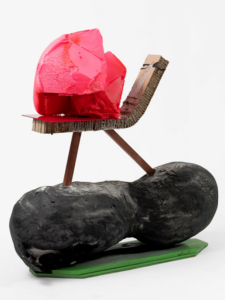
Everyday Carry, 2015
When I’m scripting, I am happiest making language objects that are complicated and specific. I want the performers to say the words exactly as I’ve written them. I use a lot of non-actors and these folks would never be able to remember everything, so we film with a live (human) prompter, feeding a performer phrase after phrase. I edit out the interstitial material and part of the fun is pressuring my edits with the goal of generating a final performance so smooth and funny that (even though there are hundreds of edits in every minute of video), the performer comes off as preternaturally voluble. I’m a really active director. I’m constantly interrupting, sculpting the performance, so there’s a lot of that stuff that needs to be cut out. That’s part of the liberty I take while directing, right, because I also know that the “joins” (as some editors refer to them) produce meaning. In my last video though, Mysterious Fires, I decided while editing to include some of the informal moments: directing the actor, giggling with one another. In allowing viewers to witness this material, I was able to discuss new subjects like how art arises from sociality, how form arises from flow that is already happening, not from some distinct exalted, estranged art-zone. I thought of it (the inclusion of this material) as a way of re-valuing love, community, affect.
CK: The titles of your work are also very intriguing. Can you discuss the concept of title as it emerges in your work? How do titles work towards or push against terms of categorical definition? Does the title in any way limit the possibilities of what the work can do?
HD: I do the titles last. I always know what the strange, affective truth of my interest was while making a piece. When I title, I’m trying to reify that, while knowingly providing specific registers and references through language. They’re packed little poems—sometimes they even contain fragmented quotations or short jokes. So, yes, there’s a lot to each title. The title might limit, but there is no problem with that at all. In fact I’m trying, with the title, to de-limit a reading, direct a viewer.
CK: Much of your art responds to philosophical theories, yet it doesn’t feel overly intellectual or static; in fact there is a distinct emotional texture to your work. Would you discuss the emotional qualities of your work in general and how theoretic speculation interacts with those qualities?
HD: During my childhood and for the first decade of my career, which included live performance, creative writing, and filmmaking, I was absolutely concerned with addressing emotion. Back then I thought emotionality was the only way to reach people and hold them long enough to communicate. Also relevant: I’ve always had a love for, a devotion to, and a knack for making narrative-based work that generates humor and pathos at once. I think of Richard Pryor here as a sort of magnificent example of that, a big influence. And also these Bette Midler VHS tapes (of her Broadway shows) I hoarded as a kid, which for some reason intermingled in my mind with her stellar, crushing performance as Janis Joplin in that movie, The Rose. There’s this moment, when playing Janis Joplin, she is singing “Let Me Call You Sweetheart” really slowly and weakly, and then she just collapses. These strange moments shape us forever. Ha ha.
Some people say an artist works on only one question in a career. I absolutely believe I’ve been lucky enough to have two.
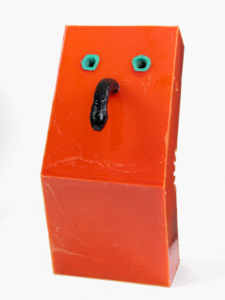
In this Hole / Honey Bucket (Consent not to be a Single Being Series), 2015
Right after I was done with By Hook or By Crook, I lost interest in pressing on the possibilities of narrativity/emotionality as my main tool for effecting communication, change, relation. Like a lightning bolt, I suddenly wanted to employ an attention to structure almost exclusively, and sought to have form or flow be the effervescent stew from which experimental vapors arise. I got into theory, science, philosophy, and history, and started experimenting with more poetic forms.
Worth noting: I think that I worked so hard and so long in narrative, and have such a deep love of humor entwined with pathos, that even when I pay no attention to it, it’s still one of the oft-used tools in my box. I still use character, I guess, to deliver inquisitions on structure. My video Love Streams is an example of that, where a performer delivers monologues about how these extension arms are built. (It’s an extended, off-kilter metaphor about quantum entanglement.)
The fact is, even though a lot of the early work was narrative, I’ve been interested in poetics since I was young. I have always liked things that were kind of hanging together but also falling apart at the same time, or being formed in situ. I could feel the reverberations between two words, say, in a poem, much more than in a story and I like the weird echo, all of that energy happening in the space between things. Narrative is so bossy and overwhelming. It’s like the worst kind of narcotic—especially if you want to communicate about structure. That said, I think it’s generative for me to use media and forms that I am suspicious of. I sort of stay irascible. If a thing gets too coherent, “Oh I got to figure out how to knock this back down.” There’s like a fracas that is always on.
I read everyday, before and after studio work. This pleasure is one thread of what I call the erotics of my practice. I also heed physicalized desires (I guess you could call these libidinal urges) during moments of making, or choosing materials. But I don’t understand those zones (libidinal) as distinct from theoretical interests (intellectual)! My point is that I experience these impulses/pleasures as absolutely mutually imbricated, mutually generating. In this way, (bodily saturation with erotic pleasures via extended bouts of thinking) I mean that quite often structures I’ve been researching will, in some way or another show up in the work.
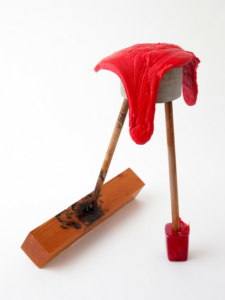
Night Goat, 2013
CK: Your work also seems to spring from language, particularly when I look at your drawings, paintings, and sculpture. It’s tempting to describe your art as visual writing. Would you describe your relationship with language and how it develops as a process for artistic production?
HD: I have to admit I experience language as a sensory faculty, like little raccoon hands on an acorn—a weird mental haptic. And conversation as one of our options for being together physically, like aural frottage. In my case, as I said, thinking, reading language: they’re full body pleasures, not totally distinct from the feeling of hot sand or a poke in the eye.
I read a lot of theory, a lot of nonfiction. One book leads to another. When I go into the studio, or into a generative mode, I don’t try to make diagrams of what I’ve been reading, and I don’t worry (specifically) about “legibility.” I assume that my cells have been saturated in the information I’ve been thinking about, and I let those “cellular intelligences” go to work. Often the larger organism (one’s whole body) is way ahead of the language-based computations conventionally understood as located in the brain. I like to listen to my whole body talking (as if you could ever do otherwise!)
CK: Your text, The River of the Mother of God: Notes on Indeterminacy, V2. (A work in progress), strikes me as a performative of the whole notion of human indeterminacy, as if it were a philosophical proposition about the aggregation of “possibles” within human experience and the transitional nature of the ephemeral “Thing-in-itself.” One of the many interesting explorations of this piece has to do with relationship—juxtaposition and place. Could you describe how this project began and how you see this kind of work developing for you in the future?
HD: A few things:
- Maggie [Nelson] was finishing her book, The Argonauts, and I kept reading and advising her to add more theoretical information about indeterminacy, to make it sort of encyclopedic on the subject of flow, continuousness. I had these lists of situations, philosophers, years of research. She would say, “That is your book, not my book.” Or something like that. “You should write that one.”
- At the same time I had just read the [Hito] Steyerl article, “On Free-Fall,” and felt oddly compelled to connect it to this [Gertrude] Stein essay about how she loves verbs.
- I had had a show at just that point, Meaty Beaty Big and Bouncy, which I had really worked hard on, but which had been at a museum in Connecticut. Very little personal conversation was generated from that show (#isolated&dejected), and I wanted to do a kind of (social) experiment in which I tried, explicitly and generously, to outline my specific thoughts and interests. I wondered if, in this way, I might be able to connect more certainly, begin conversations: Is language (in its way) a social fabric? A magic carpet that can bridge us (however imperfectly) for long moments?
- I needed a matrix that could house this series of observations, collected research. Implicit in a discussion of place, or orientation, is relation. In a discourse on poetics of relation, by definition you have difference, encounter, verbs, and so the notion of action (change) becomes a fulcrum. Using orientation as a kind of theme, River of the Mother of God could fold and flower from that point, or maybe that condition. Rather than being borne solely by words introduced as symbols, the ideas could slide against the form (as the form) and make meaning in that way as well.
CK: In this textual collage, language is the medium for artistic exploration, but it is also the subject of the exploration, suggesting a parallel with the way our bodies deliver the perception of experience as embodied beings. What do you see at the possibilities and/or limitations in which working with, or transforming, language affects the way humans experience one another?
HD: I mean, let’s face it, there a lot of ways of using language, so what are we talking about? Poetics, road signs? And while language is amazing, it’s not everything. Remembering that it’s not a zero-sum game is half the battle. (One of the things discourse can do—ecstatically—is augment, knit, even secrete, human sociality.)
That said, I acknowledge that language teaches us, by its apparent specificity, to expect mastery, crave mastery. I mean that’s cultural too: injunctions, coercive at best, which seek to manage, compress, excise specificity from our otherwise infinite or fractal-tastic experiences.
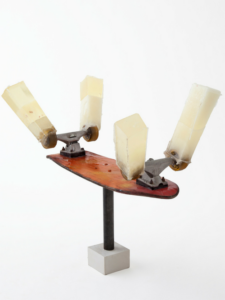
Supernumerary Phantom Limbs and The Comedy of Reciprocal Interference, 2013
The pressure, the sinking feeling that the “real” should be quantifiable, navigable, and describable in language is a place where we flounder. I might be looking at some art and bringing my attention to bear on the piece and that bodily experience is in some real sense, proliferative, chaotic, maybe even infinite. There’s something about the pressure of the rational, these gridded, clacking protuberances exploded off of the Enlightenment, the worst parts of Humanism, and the history of that, that needs to be re-thought. We have this devaluation, this amputation of all kinds of bodily experiences, or what I call non-language knowings. It’s forcing a sort of stultifying binary, which is “This is rational or irrational” rather than, “I know this thing by this other set of parameters—one of myriad ways of knowing.” It’d be cool if we didn’t have to go straight to the word “irrational,” which has a specific connotation.
Relevant here: poetics as a way of addressing this unknowable. And maybe this is obvious, but check out Adorno’s theory of “Non-Identity” as outlined in Jane Bennett’s Vibrant Matter. She defines it as what’s left over after you make a concept, “the preponderance of the object.” Here’s a passage from Bennett:
Non-Identity is the name Adorno gives to that which is not subject to knowledge…it is a presence that acts upon us: we knowers are haunted he says, by a painful, nagging feeling that something’s being forgotten or left out. This discomfiting sense of the inadequacy of representation remains no matter how refined or analytically precise one’s concepts become. ‘Negative Dialectics’ is the method Adorno designs to teach us how to accentuate this discomforting experience and how to give it a meaning. When practiced correctly, negative dialectics will render the static buzz of nonidentity into a powerful reminder that “objects do not go into their concepts without leaving a remainder” and thus that life will always exceed our knowledge and control. A sort of ethical project par excellence, as Adorno sees it, is to keep remembering this and learn how to accept it. Only then can we stop raging against a world that refuses to offer us the ‘reconcilement’ that we, according to Adorno, crave.
So poetics (language-based or otherwise) feverishly practiced, is a way we can attempt the impossible work of addressing that which is unknowable—encountering affect. And worth noting: this isn’t a vague or general infinity. We’re talking about the proliferative filigree of specificity, Planck space even, difference par excellence. What Edouard Glissant calls “Relation” or “totality.”
CK: In addition to paintings, writings, and video work, you also have a body of sculptural work. Can you describe what inspires you to work in one medium rather than another?
HD: Each of these modes of approach allows a different tonal mode of communicating. Also each of the media institutes a different sensory and bodily grid in terms of the workday. I’m sitting, standing, typing, video-editing, texting friends to help make video, sawing, shopping, sanding, drilling, dragging charcoal around, etc. (I like to mix it up.) Also worth noting is my belief that each of the media talks back to non-art things in our world—instance by instance. E.g., if I make a video, it’s talking back to Youtube, or Facebook, or iPhone cameras. If I make a sculpture it’s talking back to bodies in space, object acquisitiveness, food, nature, the machinic.
The word drip or droop: they both have a kind of register, so to pull up an instance of the unexpected (for example) using a word, is a different challenge than to rustle an uncanny construction into a sculpture. Drawing is wry and reverberative in distinct ways. I’m interested in all of that.
Most of my video work is structured around the power of language rather than images. Which, as you may know, is considered a video sin. It’s like I ride a figurative horse into abstraction—I mean my interests are quite structural in a weird way.
…language teaches us, by its apparent specificity, to expect mastery, crave mastery.
I often think of things in terms of shapes, forms, and flows, so it’s odd that I employ so much character—emotion, as you call it, or even comedy, but for me those things, if I complicate them just enough they start to break down as signifiers, hopefully. They atomize a little.
CK: In the movie By Hook or by Crook, the character you play, Valentine, finally finds his birth mother with the help of his newly found friend, Shy. After reading Maggie Nelson’s book, The Argonauts, I discovered that this is a fragment from your own life. She describes your discovery of your own birth family in a way that feels like a continuation of the movie, as if the book was one piece in the many time-space continuums of Harry Dodge.
HD: That’s funny, I love that idea. That this character lives in different authors’ minds at discoherent times, coming and going in various voices and dimensions.
While this is true almost whole-cloth as an observation, it’s important to remind here that any piece of art, whether nonfiction or otherwise, is a construction. I mean—I think you’re all over that when you say the word “fragment” here, but to me it’s absolutely interesting. I’m not sure absolute “nonfiction representation” is even possible, right? But that’s not a lament on my part. Honestly, it’s a miracle that anything like language is even possible. I tend to view it positivistically. But sure, a couple of otherwise canny readers have asked me, “What’s it like for someone so uncomfortable with language to have a writer for a partner?” E.g., there is this structuring device in The Argonauts, which limns a conversation Maggie and I had when we first met about whether language is able to do the work of describing fluidity, or anything really. We take sides in the first part of the book, but the binary unravels. This thing is perhaps calcified in the book for the sake of navigability—and it works. It’s social—which is one of the boons of language—but not exactly factual.
Having said all of that, I want to add that the the notion of privacy (and it’s true that I’m exceptionally private) strikes me as functioning in a register or sphere that is actually fairly distinct from the machine of presenting one’s creative endeavors as social and communicative mediating objects. You see what I mean? One thing is crafted to cause or augment sociality (conversation piece)—another thing is simply the wrestling of control over moments of imminent exposure. Control-consent seems to be the hyphenated fulcrum under that particular teeter-totter. In other words, I’m much less distressed when I’m the one making decisions about how I’m represented. It’s not called exposure at that point. It’s called art.
CK: How do you view the making of art in terms of cultural dialogue? What kinds of responsibilities do you think artists have, if any, outside of the art world?
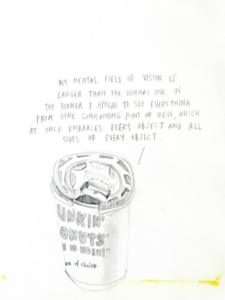
Mental Field All Sides, 2012
HD: Art, the word, the practice, protects and cultivates not only the imaginary—which alongside the agency of matter = potency—but all manner of things that defy instrumentalization by capitalism. Art (the word and practice) points at (and enjoins) all the stuff that can’t be quantified in any other way: the unnamable, the unknowable, affective inner experience, etc. The teeming open system that Glissant calls “totality” from which he subtracts “unity.” He says—and I agree—that there are things we can never know, and that “consequently we imagine it through a poetics; this imaginary realm provides the full-sense of all these always decisive differentiations.” Here, to me, poetics is a synonym for art and experimentalism in general.
Now, as social-ethical beings, citizens, friends, lovers, neighbors (aside from being artists, whose tools are fevered, demented, and poetic, and whose works should not be judged in terms linked to efficacy, transparency, or coherence) we’ve a great responsibility to be out in, discovering, entangling with, and critiquing our world, worlds.
As an aside, I do read art (not judge it) finally, each time, in terms of its contemporary relevance—invoking resonant forms (from outside of the gallery) and trying to get a sense of the relationship(s) the artist might be having to those rhyming supra-art situations/forms. But I wouldn’t extrapolate this habitual intellectualized art-reading protocol into a sort of cogent, articulated “political” injunction for art, in which a kind of experimentalism or opacity is pressured to causality in knowable ways.
CK: There is an additive dynamic to your work—a this-and-this—as opposed to this-or-that. Do you believe that identity is potentially everything that one accepts it to be?
HD: I think our identities are always on the move. Everything is always on the move. The trick is to allow ourselves to heed alternate forms of epistemological sense-making. (It’s hard to see “clearly” that thing in motion.) So identity—which is a word I almost never use any more!—doesn’t only accrue, it also winnows and alchemizes continuously (being constantly affected by every other thing). As I’ve said elsewhere, I’m very interested in the idea of a plural subject and sort of keep fondling a specific notion of multiplicity and interconnection (Relation) that is fecund, replete, with difference. In other words, homogeneity doesn’t have to be the final result of permeability. Intense articulation is not only possible, but (I suppose) inevitable. E.g., #Callmemyname.
As Glissant says, “In Relation the whole is not the finality of its parts: for multiplicity in totality is totally diversity. […] Diversity, the quantifiable totality of every possible difference, is the motor driving universal energy…”
CK: And finally, what are you reading now that might be inspiration for future work?
HD: I just started looking into what they’re calling software studies. I’m about 100 pages into The Stack: On Software and Sovereignty by Benjamin Bratton. Also into A Prehistory of the Cloud by Tung-Hui Hu. As I said, I’m a deep materialist. Lately, I’ve been (successfully) trying to alchemize/transform my neo-Luddite/technophobic thinking habits into a more dynamic understanding of materiality through reading intensely on machine consciousness and the philosophy of (the infrastructure of) network technologies and computation. The accidental megastructure. Wow, man. These last few months, it’s like I got a new brain.
